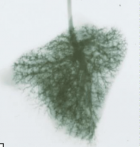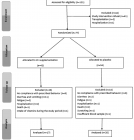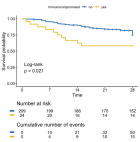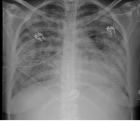About university of Porto
university of Porto
Articles by university of Porto
Effects of Fast-Walking on Muscle Activation in Young Adults and Elderly Persons
Published on: 20th January, 2017
OCLC Number/Unique Identifier: 7286424597
Coactivation of agonist and antagonist muscles participates in the regulation of joint stiffness and postural instability. Alterations on muscle activity have been revealed as an important falling risk factor. It is unclear the effects, and age-related differences, of a prolonged demanding task on the muscular coactivation levels. We compared muscle activation amplitude and coactivation of the vastus medialis, biceps femoris, tibialis anterior, and gastrocnemius medialis from surface EMG in 16 young adults (age 21-33) and 8 elderly adults (age 66-72) while fast-walking at 70% of their maximum heart rate. Overall, the elderly demonstrated higher coactivation indexes than the young individuals. Ankle coactivation decreased in the first half of the swing phase, while coactivation at the knee increased in the latter half of the swing phase in our elders. Alterations of muscle activation and coactivation on the knee and ankle were more prominent close to landing and in the swing phase. Our results suggest that these alterations may suggest potential concerns with respect to the risk of falls.
Foot Arch Differences in Elderly People at Standing: Considering Gender and Age
Published on: 13th February, 2017
OCLC Number/Unique Identifier: 7286424220
Background: The foot is an important and complex structure that provides support, balance and propulsion to locomotion, thus, its proper care can help to have a better life quality avoiding pain. The medial longitudinal arch is an important structure that is related to injury risks when it shows some impairment. The purpose of this study was to characterize the foot arch index in people in relation to age and gender.
Methods: The sample was composed of a total of 122 subjects, 79 healthy young subjects (40 women and 39 men) and 43 healthy elderly subjects (32 women and 11 men). Ten seconds of standing barefoot plantar pressure was measure through Tekscan F-Scan device, and the data processing, filtering, and arch index (AI) calculation were performed using MATLAB™ 7.0.
Findings: The elderly group presented a lower arch (AI-0.23) than the young group (AI-0.13) (p=0.000); young female and male groups show similar AI, while the elderly female group showed lower arch (AI-0.23) than the elderly male group (AI-0.18) (p=0.033).
Interpretation: The foot arch has a trend to be lower with aging, and even lower within elderly female subjects, probably due to some decrease within plantar muscle’s stiffness, that in turn may be related to lower physical activity and footwear choices.
Theoretical study on binding interactions of laccase-enzyme from Ganoderma weberianum with multiples ligand substrates with environmental impact
Published on: 19th December, 2019
OCLC Number/Unique Identifier: 9267261637
Laccase catalyzes oxidation of lignin and aromatic compound with similar structure to this one. Their low substrate specificity results on degradation of similar phenolic compounds. In this context, Molecular Docking was performed with different ligands suggesting potential bio-degradation. Binding active-sites prediction of fungal laccase (access number uniprotkb: A0A166P2X0), from Ganoderma weberianum was performed using machine learning algorithm based on Deep Convolutional Neural Networks (DeepSite-CNNs chemoinformatic tool). Herein, ligands like 2,4 - dichlorophenol, benzidine, sulfisoxazole, trimethoprim and tetracycline were analyzed and two additional reference controls which were 2,2 – azinobis 3 – ethylbenzothiazoline – 6 - sulfonic acid (ABTS) and 2,6 - dimetoxyphenol (2,6 DMP) were used in comparison with the other former mentioned ligands based on high laccase affinity. The five ligands were carried out because their potential biotechnological interest: the antibiotics sulfisoxazole, trimethoprim and tetracycline, and xenobiotics 2,4 - dichlorophenol and benzidine. Molecular docking experiments returned Gibbs free energy of binding (FEB or affinity) for laccase-ligand complexes. The best docking binding-interaction from each laccase-ligand conformation complexes suggest great ability of these ligands to interact with the laccase active-binding site. Herein, FEB values (kcal/mol) were obtained with higher affinity values for reference controls like 2,6 - dimethoxyphenol with -4.8 Kcal/mol and ABTS with -7.1 Kcal/mol. Furthermore, the FEB values were -4.7, -6.5, -6.8, -5.2 and -6.5 Kcal/mol, for 2,4 - dichlorophenol, benzidine, sulfisoxazole, tetracycline and trimethoprim respectively with high prevalence of hydrophobic interaction with functional laccase binding residues. Lastly, this study presents for first time at the bioinformatics field a molecular docking approach for the prediction of potential substrate of laccase from Ganoderma weberianum towards biotechnological application.

HSPI: We're glad you're here. Please click "create a new Query" if you are a new visitor to our website and need further information from us.
If you are already a member of our network and need to keep track of any developments regarding a question you have already submitted, click "take me to my Query."


















































































































































